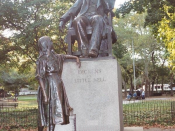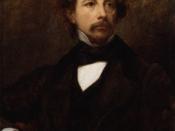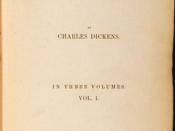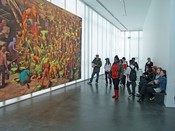AShusterman and the Aesthetic Experience Oh, how the concept of analytical aesthetics has been construed, confused, consumed, massaged, reworked, wrestled, swallowed and digested and spat out in so many different forms of philosophical vomit (for lack of a better word). Can it be possible that the fruits of this immeasurable labor are unclear, after so many decades of toil, if present at all? Modernity is responsible for the coining of the term aesthetic. The word served to rid the art world of beauty, so to speak, in favor of a more specific, descriptive term that explained not only the work but also the experience coupled with the viewing of the work. Richard Shusterman would probably say that the term has gotten a little out of hand, and for this reason he has attempted to nurse this so called aesthetic experience back into it's full bodied figure. In his essay the End of the Aesthetic Experience Shusterman attempts to explain how analytic aesthetics misunderstood the notion of the aesthetic experience and how this is not only relevant but important to the contemporary art world.
In this essay, I will explore Shusterman's ideas concerning these concepts, and discern his validity and his theory's ability for implementation into the current art world. Shusterman makes a point of noting that the aesthetic experience from Dewey to Danto has made an obvious decline. He notes, "While Dewey celebrated aesthetic experience, making it the very center of his philosophy of art, Danto virtually shuns the concept." Why now, according to Shusterman, is this decline possibly tragic? We will see⦠Before dissecting his formula, or rather map of the basics of aesthetic experience, it is necessary to fully understand the paradoxical and conflicting arguments previously made concerning the aspects most important to the aesthetic experience, as stated by Shusterman. The two basic schools are as follows: the first view states that aesthetic experience cannot be seen as unchanging and only applicable to fine art. This is because it can extend beyond fine art and because the experience is a conditioned one, susceptible to outside influence that can actually harbor or even prevent the experience altogether. Therefore if the capacity for a certain aesthetic changes, we as viewers must change with it in order to continue to fulfill our aesthetic needs. Regardless, the experience is first and foremost established upon the idea of pure viewing pleasure. The impression we get from a work of art's visual qualities is our foundation for deeming the work aesthetic. We can call this view "phenomenological". The second view reasons that, as Shusterman states, "aesthetic experience requires more than mere phenomenological immediacy to achieve its full meaning⦠Immediate reactions are often poor and mistaken, so interpretation is generally needed to enhance our experience." In other words, conceptual interpretation is not only important regarding the reception of the work, but also within the artist's studio, in that under this doctrine artists now have the license to place meaning behind their work, and have this aspect of their work be critically analyzed. In short, as Shusterman puts it, "The decline of aesthetic experience in analytic philosophy⦠stems from confusions arising from the changing role of this concept in Anglo-American philosophy from Dewey to Danto, and especially from the fact that this diversity of roles has not been adequately recognized."(pg.32) Shusterman recognizes this confusion and attempts then to "articulate its contrasting conceptions," as opposed to unifying them in one "univocal concept." How does he do so? Shusterman explains that were we to break down these conceptions into three separate axes whose oppositions can include all conflicts and confusions, we will be closer to a realistic view of aesthetics from which we can iron out the inconsistencies. The first axis asks whether the concept of aesthetic experience is honorific and evaluative or descriptive. Dewey is used as the example of honorific beliefs in art. He strives for a unification of art and life, and within the experience of viewing, he is faced with a question of whether or not the piece is a good art object. The order, then, of operations is to view, to absorb, and to feel or not to feel the aesthetic experience taking a hold of the viewer. It is a more spiritual experience than the descriptive in that the reality of what is felt comes directly from inside, outside influence has little or no bearing. The response of the honorific viewer could also be described as literal, meaning that the concern is placed upon the instantaneous reaction to the piece, and what one's instincts would judge the piece as. Descriptive experience relates to the art object and describes how that object is, in relation to other objects that the viewer has previously witnessed. The relationship to other such objects is obligatory with viewers of this descriptive type. The theory on this side of the axis is stating that the aesthetic experience is about the aesthetic object as it stands comparison with another similar object. Person A attends the Museum of Contemporary Art and is confronted with a veritable deluge of paintings, sculptures or any such object and is passing through jovially when art-piece X strikes his attention. He is drawn to the work and enjoys the form and line and color's ability to produce in him a delicious warming of the soul. This feeling is automatic, and person A is an honorific viewer. Person B attends the museum on the same artsy day and is curiously attracted to the same art-piece X that A was. Person B however notes the similarity between art-piece X and art-piece Y, and it occurs to her that X gives her a much more pleasurable experience than did Y. Both persons have been subject to a highly positive experience, however look at the experience in a separate manner.
The second axis involved in Shusterman's mapping out of the aesthetic experience rotates upon the phenomenological vs. the semantic. The experience is again first and foremost in the explanation of the phenomenological standpoint, which questions how it felt to you, the viewer. The phenomenological viewer approaches the piece and is concerned with its subject matter, and how it may or may not relate to his or her own life. It takes the formality out of the critique in favor of a more specific, personal approach to the reading of the piece. The phenomenological viewer is the leisure reader who may happily read a romance novel sporting half-nude male models on the cover, simply for the feelings that the story has caused to surface within them as opposed to harboring concern for literary technique or the conceptual ideas behind the authorship. Or, a better example, the quintessential phenomenological viewer is he or she who reads Dickens Great Expectations and disregards the poetics and mastery of the language Dickens may exhibit, or the commentary of society or romance etc. that Dickens may have emphasized. This viewer bases their positive or negative criticism upon the personal feelings extracted from the piece. Quite contrarily enters the semantic viewer in this case, he who dissects the work with the skilled know how of a surgeon, and floridly fawns over the fabulous opinions Dickens exerts through the pages. They are concerned with the concepts behind the book primarily, the meaning of each character, setting, chapter; they are concerned with the beauty of the book secondarily. The entire idea of conceptual artwork was spawned from this school of thought.
The last section of Shusterman's outline describes the transformational aftermath of an aesthetic experience in contrast with the demarcational hindsight of a similar experience. The transformational experience is just that. The emphasis in this case is on figuratively transforming the viewer into a more conscious human being by means of a work of art. The viewer experiences the piece and is so taken by it that certain lucidity is gained; the comical lightbulb comes to mind in this situation where a work of art is actually the catalyst of epiphany. The experience, of course, does not have to be so dramatic, but becomes a simpler concept when hyperbole is used. The demarcational experience is not concerned with the transformation of a viewer into a more enlightened human being. Instead, the viewer is inclined to judge whether the art piece has the capacity to give the aesthetic experience. Rather than absorbing oneself within the so-called transformational abilities that the piece may have, the demarcational thought process involves the furthering of the definition of the aesthetic experience, solely for definitive purposes. Within Shusterman's theory, however, once this concept is achieved, and art pieces are looked at in order to discern its placement within the theory of aesthetic experience as opposed to genuinely and primarily enjoying the sensory qualities, the actual aesthetic dies.
We must keep in mind that this is simply an outline that Shusterman has provided us with, and it is expected that under each of the axes any person would be more inclined to agree with one side more than the other. One's strict adherence to a certain side of each category is unnecessary. Nevertheless it is importantly noted that the honorific, phenomenological, and transformational sides are in a certain conjunction that would strengthen the concept of the aesthetic experience staying alive in the art world, whereas the descriptive, semantic and demarcational viewpoints would, in Shusterman's mind, inevitably wipe out the aesthetic experience altogether. He explains this by saying, "when the aesthetic experience proves unable to supply this [artistic experience] definitionâ¦the whole concept is abandoned for one that promises to do so-interpretation." He also states that the "essentially evaluative, phenomenological, and transformational notion of aesthetic experience has been gradually replaced by a purely descriptive semantic one whose chief purpose is to explain and thus support the established demarcation of art from other human domains." (pp. 32-33) His ideal is a happy medium that would be based in the honorific, phenomenological, and transformational side yet touching over to the other in favor of more conceptually based works. In this manner, the aesthetic lives as does This theory seems to not only be extensively researched but seemingly impenetrable. Shusterman has organized thought processes of every thinking participant in the art world and has filed them like a prize winning paralegal. He has evaded critics of the formula by showing us how to specifically achieve an artistic mentality that most everyone would be more than willing to adopt. The question is simply: has he missed anything? In theory one could argue that in providing such a formulaic account of art he causes us to lose sight of the warm simplicity in which art can be enjoyed. An idealistic "Artopia" of simple sensory pleasure could be extinguished in the suffocation of technicality. Could this technicality also be extinguishing a core reason behind humankind's artmaking ? Possibly, yet I feel that if one is genuinely afraid of such consequence, one isn't forced to read the theories of Shusterman, just as one is not forced to take this class in the first place. I choose to be exited by Shusterman's efforts.








